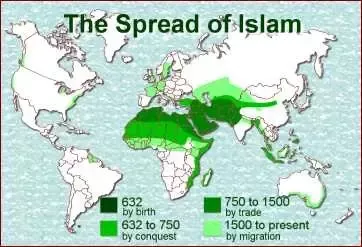
Eschatology
The study of “last things” incorporates two related concepts: the afterlife and world’s end. The Qur’an emphasizes the inevitability of resurrection, judgment, and the eternal division of the righteous and the wicked. On the day of resurrection, humans will be judged by their faith in Allah, their acceptance of Allah’s revelations, and their works. The wicked will be consigned to eternal torment; the righteous will enjoy paradise. Later commentators include a belief in an intermediate state (barzakh) between death and the resurrection and final judgment. Before the final resurrection, the terrible tribulation of the last days occurs, during which the Great Deceiver, al-Dajjal, will appear. Though not mentioned in the Qur’an, al-Dajjal is prominent in hadith and later Islamic literature, as is the Mahdi (also absent in the Qur’an). The Mahdi will appear to bring justice and truth to all, the entire world will accept Islam, and his death (before the day of resurrection) will bring turmoil, uncertainty, and temptation. There are disagreements over the Mahdi’s precise relationship to Jesus ; some deny there will be a Muslim Mahdi, claiming that Jesus’ second coming will fulfill this role. Some believe that Jesus will return as a just judge; he will die after forty years and be buried in a spot beside Muhammad ‘s tomb in Medina that has been reserved for him.
Afterlife
As in other forms of Near Eastern monotheism, the Qurʿān emphasizes resurrection, judgment, and the eternal division of the righteous and the wicked. On the day of resurrection, humans will stand before Allah to be judged according to their faith, acceptance of Allah’s revelations, and works. The wicked will be consigned to eternal torment in hell — Jahannam or nār (fire), an abyss of flame, heat, dryness, and darkness. The righteous will enjoy the pleasures of paradise (Jannah), a magical garden of light (Qurʿān, 3:190–199, 22:19–20, 36:47–57, 37:7–68, 56, 75, 76). The Qurʿān offers sensual descriptions of paradise, including the pleasures of exquisitely delicious food and drink and sexual relations with divine maidens (often interpreted metaphorically). Later commentators also provide details about an intermediate state of the soul (barzakh) between death and the resurrection to final judgment. Before the resurrection, however, the terrible tribulation of the last days will fall upon the earth.
Day Of Judgment
Although the Qurʿān does not specify the time of the judgment, it assures its readers that the day is near. It has much to say about the end of the world, especially in its Meccan sūrahs. The general picture is very similar to that given in the Bible. Great earthquakes will rock the earth, setting mountains in motion (Qurʿān, 99). The sky will split open and heaven will be “stripped off,” rolled up like a parchment scroll. The sun will cease to shine; the stars will be scattered and fall upon the earth. The oceans will boil over. Graves will be opened, the earth bringing forth its burdens — hidden sins, lost stories, and the dead. People will seek vainly to flee from divine wrath. All will bow, willingly or not, before Allah. In traditional Islamic thought, the day of judgment is a period of great cosmic conflict when the forces of Satan — represented by a false Messiah (al-Dajjāl) and Gog and Magog —combat the forces of Allah, led by the Mahdī and Jesus.
The Deceiver (al-Dajjāl)
An important Islamic eschatological figure is al-Dajjāl (the deceiver), often equated with the Antichrist. In an age of injustice preceding the end of the world, the Deceiver will appear and, for a limited period — sometimes reckoned as forty years, sometimes as forty days — will spread corruption and oppression across the earth. His appearance is one of the sure signs of the last days. Deceiving many by false teachings and miracles, he will bring with him supplies of food and water with which he will tempt those who have been suffering. Although the Qurʿān mentions no such person, he figures prominently in the ḥadīth and later Islamic literature.
The Mahdi
The “rightly guided one” also does not appear by name in the Qurʿān. Nonetheless, he plays a vital eschatological role in various strands of Islam. Not a savior from sins in the Christian sense, nor a merely national messiah as conceived in certain varieties of Judaism, he will bring justice and truth to all humanity.
In the first years following the close of Qurʿānic revelation and the death of the Prophet, Islam enjoyed virtually uninterrupted military success. The word mahdī was used during this period without messianic significance. By the late seventh century, however, after a period of considerable political turbulence, the term began to be used to refer to a hoped-for ruler who would restore Islam to its original perfection. With the passage of time, humane and just rule seemed an increasingly distant prospect. Thus, particularly following the ʿAbbāsid revolution (750), the figure of the Mahdī assumed an ever more eschatological or messianic aura.
Although the Mahdī occurs in Sunnī teaching, his role there is much less significant than in Shīʿī belief, particularly in Twelver Shi’ism, which has developed Islamic messianic tendencies to their furthest extent. In 873, the eleventh imam of the Twelvers died, to all appearances leaving no heir. Some of his disciples, however, claimed that he had concealed an infant son for safekeeping. Indeed, between 873 and 941 there were “agents” who claimed to be in contact with the young imam. By this time most Shīʿīah had come to realize that open resistance to the government was futile. These agents promised th”at, at the right moment, the hidden twelfth imam would emerge to redress the community’s wrongs. As the years passed and he did not appear publicly, this figure acquired an ever more obviously messianic character, drawing on elements of other religious traditions to flesh out his image. After the elapse of a normal human life span, it began to be felt that the absent twelfth imam was in fact the Mahdī, who was being held in supernatural occultation from which he would someday return in glory to “fill the earth with justice as it has been filled with oppression.” Believers were to be faithful, obedient, and alert, watching for the “signs of the times” and evaluating passing events in the light of apocalyptic prophecies circulating in the community.
The Mahdī of the Twelvers is thought to reside in Mecca, or at least nearby. It is said that he makes the pilgrimage each year, unrecognized. The Mahdī of the Twelvers is thought to reside in Mecca, or at least nearby. It is said that he makes the pilgrimage each year, unrecognized.
Islam, like Christianity, speaks of seven years of tribulation (troubled times). In 2014, the Grand Ayatollah of Iran, Sayyid Ali Hosseini Khamenei (a Shi’a Muslim), claimed he’d had a personal conversation with al-Mahdi. The Mahdi told him that the Islamic seven years of tribulation would begin in 2015 and al-Mahdi would make his appearance in 2022. Shortly before he was killed, al-Baghdadi (a Sunni Muslim), the leader of ISIL/ISIS/IS, agreed with Khamenei.
The reappearance of the Mahdī will occur at the Kaba in Mecca, accompanied by spectacular signs including the rising of the sun in the west and unusual eclipses in the holy month of Ramaḍan. However, the Mahdī will not remain in Mecca. First he will go to Medina, and then to Kufa, where he will establish his capital. Ḥusayn, ʿAlī, and the Prophet will also return, with the first two taking especially important roles in the establishment of Islamic rule. The entire world will thereafter accept Islam, willingly or by force. The Mahdī will die some time before the day of resurrection, and a brief period of turmoil, uncertainty, and temptation will follow his death.
Both Sunnī and Shīʿī traditions about the Mahdī agree that he will rule the world and bring great wealth, which he will distribute generously; however, his reign will be short. In the Shīʿī view, he will force everyone to accept Shi’ism. While most Muslims expect him to restore the integrity of the Shari’a, a minority through the years has taught that he would do away with Islamic law, bringing a new prophetic message in its stead.
He will disclose himself publicly on ʿĀshūrāʿ, the tenth day of the month of Muḥarram and the anniversary of the martyrdom of the Prophet’s grandson, Ḥusayn (680 AD). Thus, the well-known Shīʿī commemoration of ʿĀshūrāʿ expresses not only sorrow for the death of their beloved martyr but also hope for a cessation of suffering and injustice to be effected by a descendant of Ḥusayn. The reappearance of the Mahdī will occur at the Kaʿbah in Mecca, accompanied by spectacular signs including the rising of the sun in the west0 and unusual eclipses in the holy month of Ramaḍan. However, the Mahdī will not remain in Mecca. First he will go to Medina, and then to Kufa, where he will establish his capital. Ḥusayn, ʿAlī, and the Prophet will also return, with the first two taking especially important roles in the establishment of Islamic rule. The entire world will thereafter accept Islam, willingly or by force. The Mahdī will die some time before the day of resurrection, and a brief period of turmoil, uncertainty, and temptation will follow his death.
Both Sunnī and Shīʿī traditions about the Mahdī agree that he will rule the world and bring great wealth, which he will distribute generously; however, his reign will be short. In the Shīʿī view, he will force everyone to accept Shi’ism. While most Muslims expect him to restore the integrity of the Shari’a, a minority through the years has taught that he would abrogate Islamic law, bringing a new prophetic message in its stead.
Second Coming Of Jesus
As the doctrine of the Mahdī developed, disagreements occurred over his precise relationship to Jesus. Some Muslim thinkers denied that there will be a Muslim Mahdī, claiming instead that this role will be fulfilled by the second coming of Jesus. Post-Qurʿānic legends, which still persist, had also grown up about the second coming of Christ. Some say that Jesus will return as a just judge. One prophecy says that he will descend in Palestine, where he will kill al-Dajjāl; he will then worship at Jerusalem, where he will kill both swine and those who disbelieve in him. He will die after a peaceful reign of some forty years and be buried in a spot beside the tomb of Muḥammad in Medina that has been reserved for him.
Antichrist
Known as Dajjal (the deceiver). Supposed to appear during the age of injustice preceding the end of the world, causing corruption and oppression to sweep over the earth for a period of either forty days or forty years. Appearance is one of the sure signs of the last days. Will deceive many by false teachings and miracles, bringing with him food and water to tempt those who have been suffering. Not mentioned in the Qur’an, but prominent in Hadith and later Islamic literature. Correlates to Christian apocalyptic legends about the Antichrist. Medieval Christians often portrayed Muhammad as the Antichrist. Many evangelical Christians today portray Muslims as agents of the Antichrist.
Modern Significance
While many modernist Muslims, influenced by western secularism, tended to allegorize traditional eschatological beliefs, those beliefs never disappeared. The Bābī and Bahāʿī movements in early nineteenth-century Iran, for instance, drew from traditional Shīʿī eschatology, as did the 1979 Iranian Revolution. Mirzā Ghulām Aḥmad (1835–1908), founder of the Aḥmadīyah movement in Pakistan, proclaimed himself the Mahdī, taking eschatological ideas from Hinduism and Christianity as well as Islam. Eschatology was fundamental in the founding of the Sudanese Mahdist state by Muḥammad Aḥmad ibn ʿAbd Allāh (1843–1885). Likewise, the seizure of the Grand Mosque at Mecca in 1979 was based partially on Mahdist ideological claims. And, of course, the focus on martyrdom among both Shīʿīs and Sunnīs is linked to the Qurʿānic concept that death in the path of Allah guarantees entry into paradise.
Indeed, eschatological ideas are experiencing a resurgence in the contemporary Islamic world. As it has historically done, apocalyptic thinking appeals to those who feel themselves defeated, dispossessed, oppressed, and disillusioned. One novelty in contemporary Islamic eschatological speculations, much more prominent than in the classical sources and expressly reflecting Western anti-Semitism, is a strong current of anti-Judaism. Also characteristic is a desire for the restoration of the caliphate, which, its advocates assume, will return the Islamic community to unity and strength from its current state of fragmentation and weakness. Strikingly, though, contemporary Islamic apocalypticism tends to emphasize the horrific nature of coming events more than the presumably millennial state that will follow them.
Eschatology
623 – 001
Last Updated: 06/2021
Copyright © 2017-2021 Institute for the Study of Islam (ISI) | Institute-for-the-study-of-Islam-org | Discerning Islam | Discerning-Islam.org | Commentaries on Islam | © 2020 Tips Of The Iceberg | © 1978 marketplace-values.org | Values In The Marketplace | are considered “Trade Marks and Trade Names” ®️ by the Colorado Secretary of State. All Rights Reserved.



